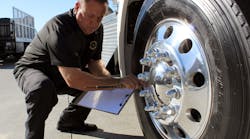Before I share my thoughts on scrap tire analysis, let me state that I hate the phrase “scrap tire pile.” The phrase conveys the idea that the tires in such a pile don’t have much value. Nothing could be further from the truth.
First, if you look through enough tire piles, you’ll find that many discarded tires are actually fit for continued service. Negligence and haste can cause many useful tires to be mixed up with those that should be discarded.
More importantly, the information hidden in those “junk” tires can be the key to reducing your fleet’s tire costs – provided that a serious effort is made to squeeze information out of the pile.
TIRE INSPECTIONS
The core knowledge that will be used for improving costs is gained through tire inspections. The job is going to be dirty, so it is advisable to wear gloves. Some tools that will be useful in getting the best results from your inspections are:
1. A tread depth gauge.
2. An awl to probe punctures and separations.
3. Pliers to “open” cuts.
4. A tire crayon to mark findings.
5. A clipboard to record findings.
If there are a large number of tires to go through, it’s a good idea to have a helper. The job will go faster if you’re not putting down your tools and picking up a clipboard after every tire inspection. “I’ll inspect, you write” is a good strategy.
Possibly the most important tool when looking at out-of-service tires is a conditions guide. Yokohama Tire Corporation has a few common conditions photographed and explained on www.Yokohamatruck.com. However, a more exhaustive resource is Technology & Maintenance Council’s Radial Tire Conditions Analysis Guide.
For many years, Yokohama and other tire manufacturers have collaborated with fleets and service providers to compile an excellent “What caused this?” manual. The intended user is a fleet manager and the book is easy to use. Simply find a picture that looks like the tire you are inspecting and then read about the likely causes and appropriate countermeasures.
Don’t be surprised if the guide tells you that some tires can be returned to service.
DETAILS
As you inspect tires, the more information you have, the better. Knowing the vehicle ID and tire position can be very beneficial.
For example, steer tires from the same vehicle can be compared to identify a misalignment condition. Dual tires that have vastly different appearance can indicate that they were running at different pressures.
Knowing the removal mileage is equally important. A steer tire irregular wear condition might be acceptable at 150,000 miles but unacceptable at 50,000 miles.
If you’re not making these notes on tires as you remove them, consider starting.
Some fleets would be happy to write the removal mileage on tires, but don’t know what it is.
Tracking and improving tire performance starts with recording the odometer reading at the time of tire installation. Methods vary form paper and pen to proprietary computer systems, but every fleet should know – or at least be able to dig up – the install date and odometer reading for every steer and drive tire running.
TYPICAL CONDITIONS AND SOLUTIONS
Here are some common tire service conditions. Also provided are ways to correct the problem.
- Shoulder Wear. Shoulder wear on steer tires can be caused by misalignment, poor bead seating and under/over inflation. Being able to match up removed steer tires is a key advantage in understanding the root cause of shoulder wear.
- Punch Wear. One or two fast-wearing ribs on the interior of a tire can be an indication of low pressure. Low pressure issues can be solved with staff training and regular audits. Have a supervisor or third-party randomly check pressures once per month.
An old friend of mine routinely reminds me: “People don’t do what you expect. They do what you inspect.”
- Erratic Wear. Irregular wear that doesn’t follow an obvious pattern is usually a sign of a mechanical problem. However, it can also be caused by poor installation/mismount or mismatched pressures across duals.
- Tread Damage. Trucking can be a rough business. The forces acting on a tire are severe and road surfaces vary. Some snags and chips can be expected, but if tread damage is consistently causing tires to be pulled from service, there may be better tire choices. Consider evaluating a tire with more damage resistance.
- Separations. Tires are designed to stay in one piece throughout their service life. If separations are occurring, this usually points to a pressure maintenance problem.
I once visited a fleet that was battling lower sidewall separations. They were very diligent to check tire pressures, but they checked the tires immediately upon arriving at the terminal, when they were still hot. Worse yet, they bled air out of the hot tires to reach the fleets pressure spec.
They didn’t realize that their diligence was working against them. Every tire in the fleet was 10 to 15 psi underinflated.
Always check tire pressures when cold and use a calibrated pressure gauge. Never bleed air from a hot tire.
If you’re not sure what pressure is best, talk to your service provider or check an online pressure calculator like the one at www.yokohamatruck.com.
BE DILIGENT
The best way to lower tire costs is to attack the top causes for removal. The top causes vary from fleet-to-fleet, so the only way to plot a good course is to look at every tire being removed from service.
If you’re new to tire conditions analysis and need help getting started, ask your tire dealer or manufacturer.
Don’t let anything deter you from letting your tires “tell” you how to lower your costs. Those discarded tires may be more of a gold mine than a scrap pile.
Tim Hume is a technical engineer with Yokohama Tire Corporation (www.yokohamatire.com). It is the North American manufacturing and marketing arm of Tokyo, Japan-based Yokohama Rubber Co., a global manufacturing and sales company of premium tires since 1917. Servicing an extensive sales network throughout the U.S., Yokohama Tire offers a complete product line that includes tires for high-performance, light truck, passenger car, commercial truck and bus and off-the-road mining and construction applications.





